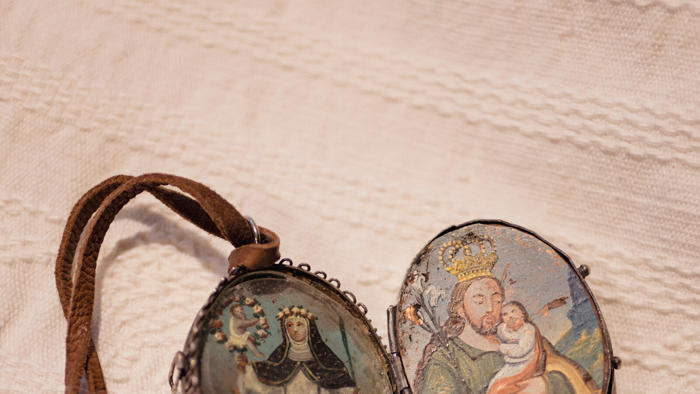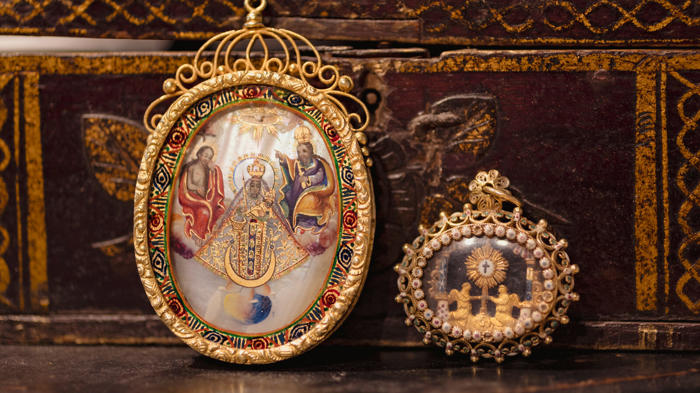Latin America Has a Rich Tradition of Religious Pendants

A relicario from 19th century Mexico. The art pieces, which consist of depictions of religious figures set in metal bezels under glass, first rose to popularity in medieval Europe.
CORRALES, N.M. — Martha J. Egan has spent decades rummaging around markets and antique stores across Latin America in search of the rare, carefully crafted devotional pendants called relicarios.
Her hunt has led her to amass more than 400 of the objects — pronounced reh-lee-CAR-yos; in English, reliquaries — and to write two books about what she has come to view as an overlooked genre within the body of religious art created during the Spanish colonization of the New World.
Of course, “there was not much art in the colonial era that was not religious,” said Ms. Egan, 78, who has a bachelor’s degree in Latin American history.
Typically, the pieces (sometimes called medallones or miniaturas) were pendants with painted, carved or printed depictions of favorite saints or the Virgin Mary on both sides, set in metal bezels under glass. Made for people in a range of social and economic classes, some relicarios were plain while others were elaborately decorated; their creators were usually anonymous.

Two gold relicarios at Casa Perea Art Space in Corrales, N.M. One, left, is a 19th-century Bolivian piece featuring a curved seashell painted with the crowning of the Virgin Mary; the other, an 18th-century Spanish relicario featuring two angels.
Perhaps because the pieces were worn as personal expressions of devotion, they largely have gone unnoticed, Ms. Egan said.
“Art historians have totally blown them off,” she said during an interview at Casa Perea Art Space, a 19th-century adobe event venue that she owns in Corrales, N.M., a village just outside Albuquerque. The building also houses her folk-art store, Pachamama, which opened 50 years ago and sells handmade items from Latin America, primarily Mexico, Peru and Bolivia.
Small but Important
The word relicario traditionally has been used for any receptacle for relics such as splinters said to be from Jesus’s cross or fragments of bone or bits of cloth said to have ties to saints or other religious figures. Such devotional pieces, including lockets, were popular in parts of medieval Europe.
During the Spanish colonial period — which began at the end of the 15th century and lasted for more than 300 years — large quantities of relics were shipped to the Americas. But, Ms. Egan said, most were reserved for the Roman Catholic churches being built as part of the push to convert Indigenous populations to Christianity.

Ms. Egan examining a 17th-century Mexican relicario at Casa Perea. She said many people considered the pieces to be amulets that would protect them from harm.
As a result, some in the New World began to create or commission pendants that did not contain relics but were still considered relicarios, as Ms. Egan described in her books “Relicarios: The Forgotten Jewels of Latin America” (2020) and “Relicarios: Devotional Miniatures from the Americas” (1993).
Gabriela Sánchez Reyes, an art historian who has a Ph.D. in social sciences and works at Mexico’s National Institute of Anthropology and History, said in a video interview that research on reliquaries tended to focus on grand objects such as ornate silver vessels from churches. But Ms. Egan’s work, she said, “compelled us to turn our eyes to see a small object that has its own important features, its own artistic virtues, and speaks to us of the devotion of an era.”
Dr. Sánchez Reyes said that only a handful of researchers in Mexico had written about these pendants — and that Ms. Egan’s first relicario book planted the seed of her own interest about 25 years ago, prompting her to include a chapter on them in her master’s thesis.
Such pendants, however, are in many of the world’s museums. In Mexico City, for example, the National Museum of History in Chapultepec Castle and the Museo Soumaya have two of the country’s most noteworthy collections, Dr. Sánchez Reyes said. (A decade ago she was a co-curator of an exhibition at the Museo Soumaya, “Sanctuaries of the Intimate,” which included relicarios and miniature portraits from the institution’s permanent collection.)
Alfonso Miranda, the director of the Soumaya, said relicarios often did not make it into museums — but that did not mean they have been forgotten. “Families continue to hold on to these relics,” he said, noting that often they were passed through generations.
Relicarios also can yield important historical information, he said; for example, the image of a specific saint might indicate that a particular religious order had been in a given geographic area.
Lucía Abramovich Sánchez, an associate curator at the Museum of Fine Arts, Boston, made a similar point, noting that the materials used to make relicarios could provide glimpses into their wearer’s relative wealth, and the portrayals of saints could shed light on devotional practices. “It enriches our knowledge of what colonial Latin American art is, or Latin American art is,” she said. “It adds a personal element.”
Dr. Abramovich Sánchez, who has a Ph.D. in art history and Latin American studies, said it was Ms. Egan who introduced her to relicarios. The two met in 2019, when Dr. Abramovich Sánchez worked at the San Antonio Museum of Art, and in 2021, she reviewed Ms. Egan’s second relicarios book for a scholarly journal.
The Materials at Hand
At Casa Perea, Ms. Egan laid out a sampling of her relicarios, some so finely detailed that the artist would have used something like a horse’s eyelash to apply the paint, she said. Several were carved from materials as varied as tagua nut from Ecuador, alabaster from Peru and ivory from Asia.
One of her colonial-era lockets from Spain had a small wooden cross in the center and fragments of material incorporated into the rest of the design. “You can tell those are bits of bone,” Ms. Egan said matter-of-factly. “Somebody’s bones. Who knows?”
Another pendant, an engraved silver case about 2.2 inches in diameter, can be opened on one side to reveal a gilded bas-relief of the Virgin of Copacabana, one of myriad representations of the Virgin Mary revered in Latin America. Beneath the lid on the reverse is an image of St. Rose of Lima, the first person born in the New World to be canonized as a saint.
Ms. Egan said the piece was made in Peru in the 1600s, its images molded from a homemade paste of mashed potatoes, a sticky liquid such as peach juice, “and probably plaster and who knows what else.”
“People are making something that’s very important to them,” she said, “but out of what they have at hand.”
From the early days of the conquest, the Spanish were impressed by the Aztec artisans’ craftsmanship. In her “Forgotten Jewels” book, Ms. Egan quoted from a letter that Hernán Cortés wrote to King Charles V of Spain while the conquistador was consolidating control over the Mexica/Aztec empire.
Cortés reported that he had asked Moctezuma, the Aztec emperor, to have his artisans test their skills on Spanish-style art, and the emperor had “ordered them to make in gold such things as holy images, crucifixes, medals, jewelry and necklaces, and many other of our things and they did it as perfectly as we could explain these things to them.”
The book included a portrait of Cortés wearing a relicario on his shoulder.
“An Abiding Interest”
The first time Ms. Egan came across relicarios was in the 1970s in an antique store in Lima, Peru. The dealer, she said, told her she was buying two-sided miniature 18th-century paintings set in silver bezels, but Ms. Egan later learned they were fakes.
Still, she credited the dealer with sparking what she described as “an abiding interest” in relicarios. Once or twice a year, when she went to Latin America on buying trips for her store, Ms. Egan would supplement the long hours of library research she was doing back home by quizzing local artisans, historians, museum curators, dealers and any other experts she could find.
Ms. Egan grew up in a Catholic family in Wisconsin, but she left the church while she was a university student in Mexico City. She still went on to immerse herself in the religious imagery of relicarios “because they’re so beautiful,” she said, adding that she understood “why they were important to people, why people would put such incredible artistic endeavor into creating them.”
For many people, she said, relicarios were amulets protecting them from harm, or comforts in times of difficulty. On a more worldly level, wearing a relicario could be a way to flaunt both faith and success, since religious ornaments were exempt from so-called sumptuary laws, regulating ostentatious displays of wealth.
And in some cases, a relicario may have served as a kind of cover during the Spanish Inquisition, Ms. Egan said.
In her most recent book, she described a relicario (not in her collection) from the Viceroyalty of New Spain — a vast Spanish territory that included modern-day Mexico — that had a card inside “inscribed with signs of the kabbalah and Hebrew writing that may have been deliberately hidden in the space between two Catholic images.”
Relicarios began to fall out of favor in Latin America in the late 18th and early 19th centuries, Ms. Egan noted, in part because of anticlerical sentiments and a growing independence movement, though, she added, the tradition lasted longer around popular religious pilgrimage sites.
Fine Craftsmanship
Bernadette Rodríguez-Caraveo, a silversmith in New Mexico, has long had a front-row seat to Ms. Egan’s collection: She worked at Pachamama years ago, before beginning a 30-year career teaching ceramics and jewelry making. She now manages both the store and the event space at Casa Perea.
Many of the old relicarios are examples of meticulous craftsmanship, she said: Without access to modern tools or art supply stores, the artisans often managed to fit pieces together perfectly, with no visible solder lines. “It’s amazing to me that they did such beautiful, beautiful work, and such fine work,” she said.
Generally, the artisan who did the painting or carving was not the same person who made the bezel, she said, and so “some of the painting isn’t that great, but the silver work is — and vice versa.”
Ms. Rodríguez-Caraveo, 67, said she had made her own versions of relicarios, inspired in part by Ms. Egan’s collection and by her own experience being raised by her paternal grandparents in Santa Fe, N.M.
They had a simple relicario-style pendant, she said — a black-and-white printed image of the Virgin of Guadalupe, set in a small tin frame — which was usually kept in her grandfather’s pocket or in the box that held her grandmother’s rosary.
Her own relicarios have ranged from the religious to the playful. Most recently, she has custom-made silver pendants that capture figures, scenes or symbols close to the wearer’s heart or that tell a story.
“To me, a relicario is something you hold sacred,” she said.
As for Ms. Egan, she said she was no longer looking for relicarios, though she immediately added that she would buy one “if it tells me something.”
She spoke wistfully about one particularly fine piece she used to have, then seemed to convince herself that she had done the right thing by selling it to a santero, an artisan who crafts images of saints.
“He is serious, a serious Catholic,” she said, “so it’s in the right place.”
